The UK national debt is the total amount of money the British government owes to the private sector and other purchasers of UK gilts (e.g. Bank of England).
- UK public sector net debt (ex public sector banks) was £2,685.6 billion or 98.1% of GDP (20 Dec 2024).
- The OBR have forecast substantial rises in UK debt over the coming decade because of demographic factors, putting strain on UK spending.
- Source: [1. ONS public sector finances,- HF6X] (page updated 20 Jan 2024)
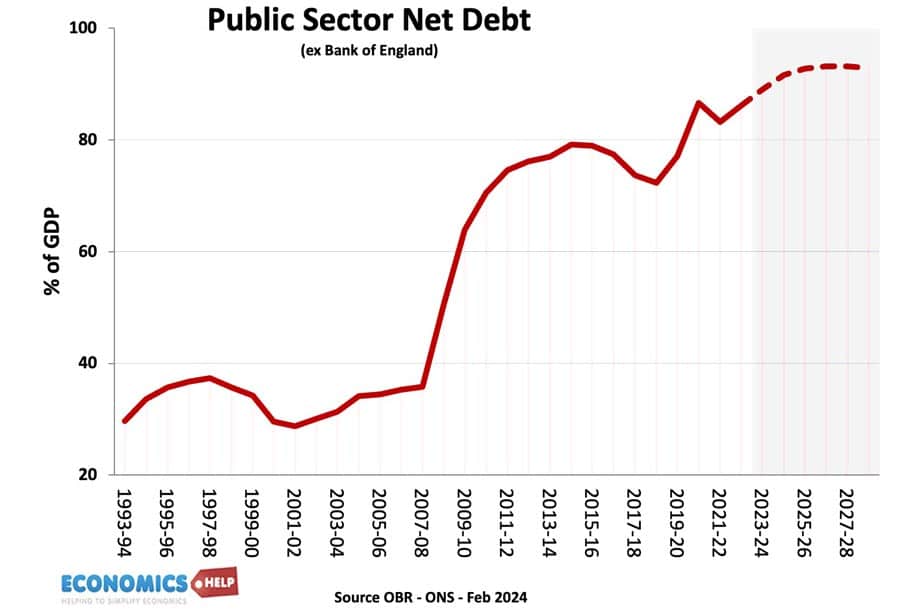
Source: ONS debt as % of GDP – HF6X | PUSF – public sector finances at ONS
Reasons for National debt
- Enables the government to spend more during periods of national crisis, e.g wars, pandemics, and recessions.
- In a recession, the government will automatically receive lower tax revenues (less VAT and income tax) and will have to spend more on benefits (e.g. more unemployment benefits) This causes a cyclical rise in debt.
- Extra government borrowing during a recession can help provide fiscal stimulus to promote economic recovery. By borrowing and then spending more, the government is injecting demand into the economy and this can help to reduce unemployment. This is known as fiscal policy and was advocated by J.M. Keynes.
- Strong market demand for government debt. Private investors buy gilts because they are seen as risk-free investments and there is also an annual dividend from the bond yield. Since 2009, there has been strong demand despite very low-interest rates, meaning the government can borrow very cheaply.
- Finance investment. The government could borrow to finance public investment projects that can lead to higher growth in the future.
- Political convenience. There is usually political pressure to cut taxes and increase government spending. Allowing debt to rise can be a way for the government to avoid difficult choices.
Forecast for the National debt?
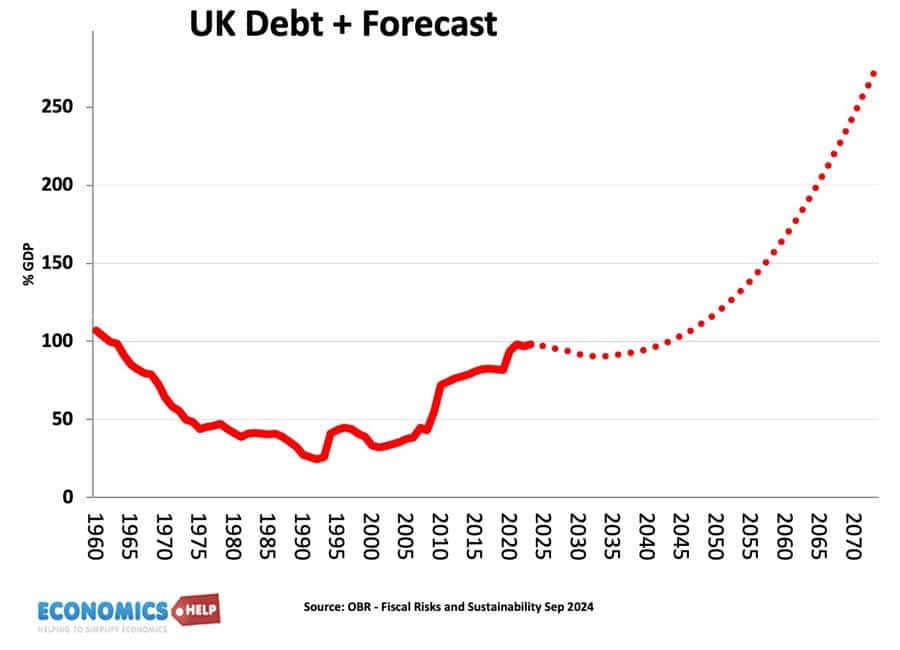
Source: Fiscal risks and sustainability – OBR – Economic and Fiscal Outlook Oct 2024
The OBR have forecast that, on our given trajectory, UK public sector debt could reach 350% of GDP within 50 years. The pessimistic outlook for national debt is made because
- An ageing population and demographic changes will put increased pressure on government spending, notably health care and pension spending.
- A smaller working population will limit UK’s productive capacity.
- Stress on finances from geopolitical events, such as frostier relations with China, Russia and the Middle East.
- Higher energy prices
- Costs of climate change.
- Declining tax revenues from petrol in a decarbonising economy.
- Low productivity growth of UK since the financial crash of 2009
- Recent boost to debt from the financial crisis and one-off cost of Coronovirus pandemic, which cut tax revenues and required government support for lockdown measures.
UK debt in context
Predicting debt for the next 50 years is difficult since we don’t know what kind of productivity improvements may come, e.g. continued gains in renewable energy may reduce the burden of higher oil and gas prices. Equally, the costs of environmental change could be worse.
History of the national debt
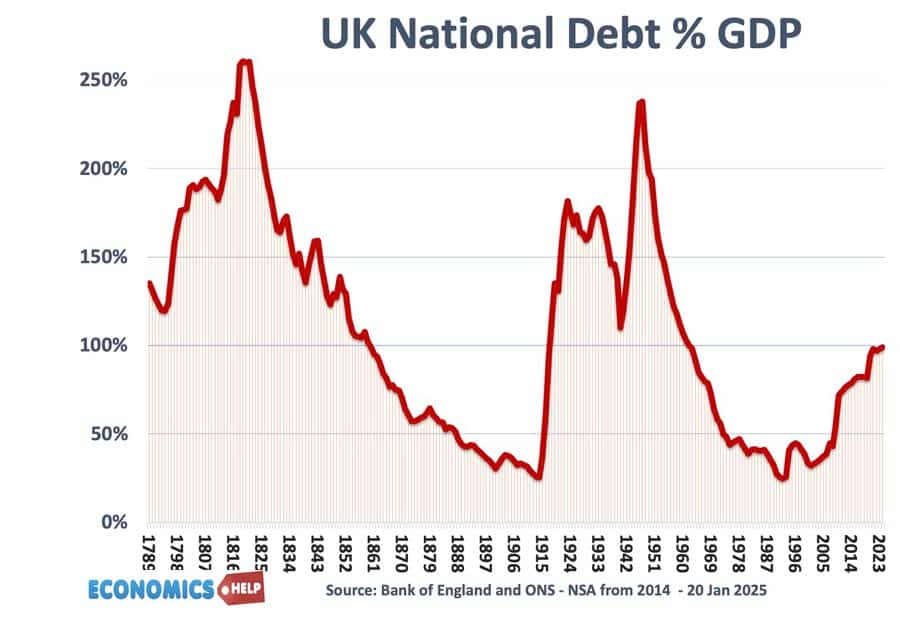
Main article: History of UK national debt
UK national debt since 1900
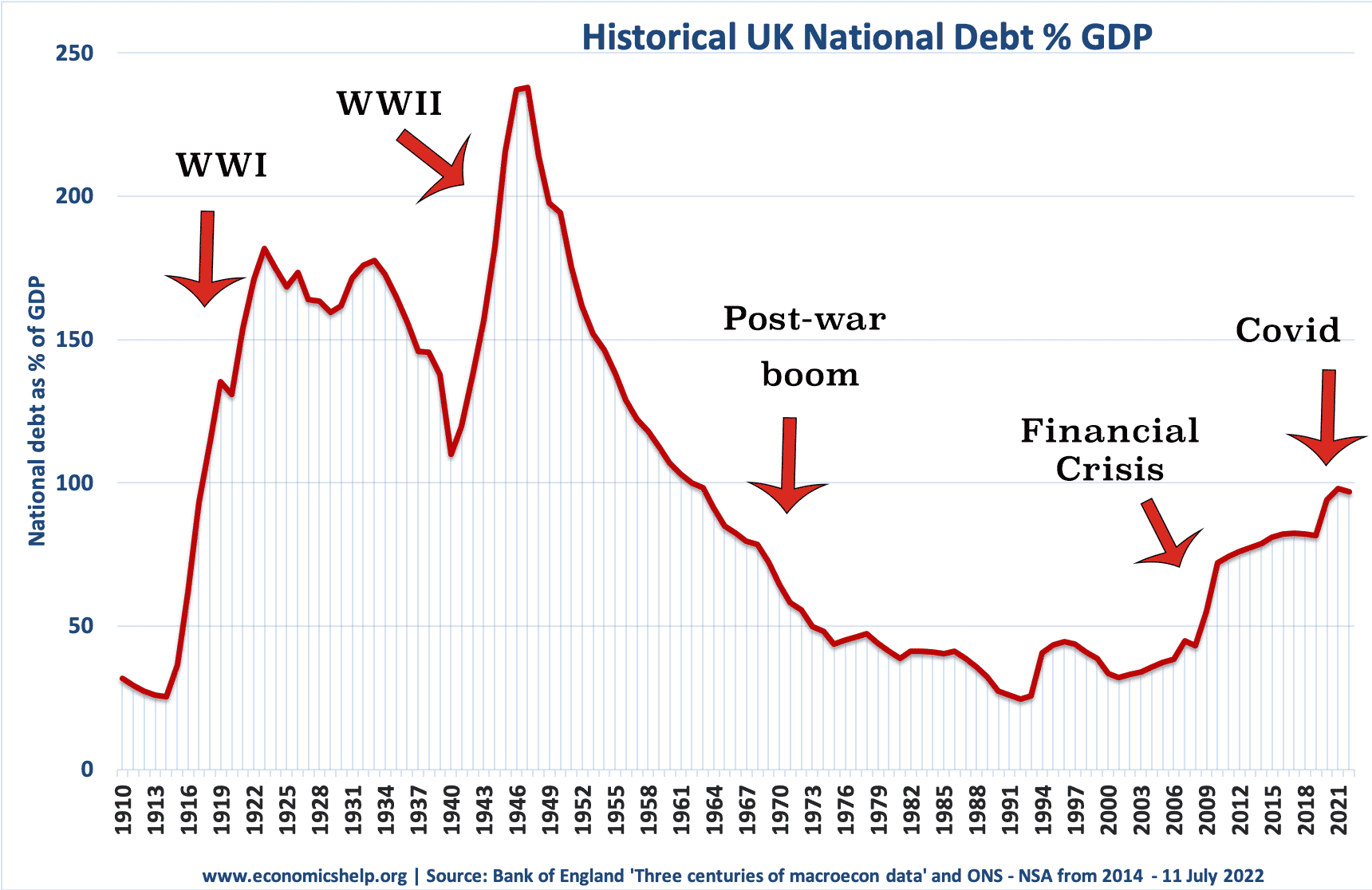
Source: Reinhart, Camen M. and Kenneth S. Rogoff, “From Financial Crash to Debt Crisis,” NBER Working Paper 15795, March 2010. and OBR from 2010.
These graphs show that government debt as a % of GDP has been much higher in the past. Notably in the aftermath of the two world wars. This suggests that current UK debt is manageable compared to the early 1950s. (note, even with a national debt of 200% of GDP in the 1950s, UK avoided default and even managed to set up the welfare state and NHS.
Debt reduction and growth
The post-war levels of national debt suggest that high debt levels are not incompatible with rising living standards and high economic growth.
- The reduction in debt as a % of GDP 1950-1980 was primarily due to a prolonged period of economic growth. See: how the UK reduced debt in the post-war period
- This contrasts with the experience of the UK in the 1920s when in the post First World War, the UK adopted austerity policies (and high exchange rate) but failed to reduce debt to GDP. Debt in Post-First World War period.
Budget deficit – annual borrowing
This is the amount the government has to borrow per year.
- Government
- borrowing in the financial year to December 2024 was £129.9
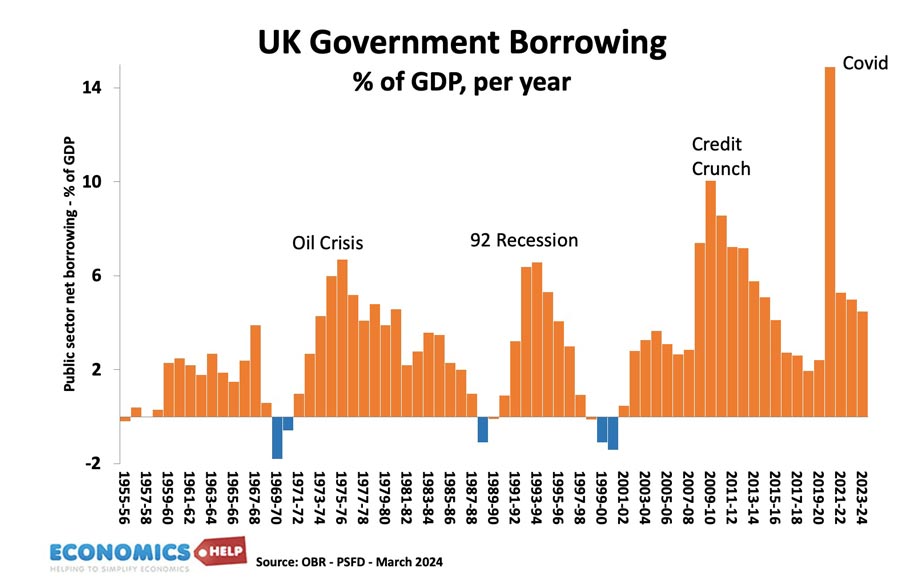
Annual borrowing since 1950. Figures for 2023-24 are forecasts (and rather optimistic!)
Debt and bond yields
Bond yields a the interest that the government pay bond/gilt holders. It reflects the cost of borrowing for the government. Lower bond yields reduce the cost of government borrowing.
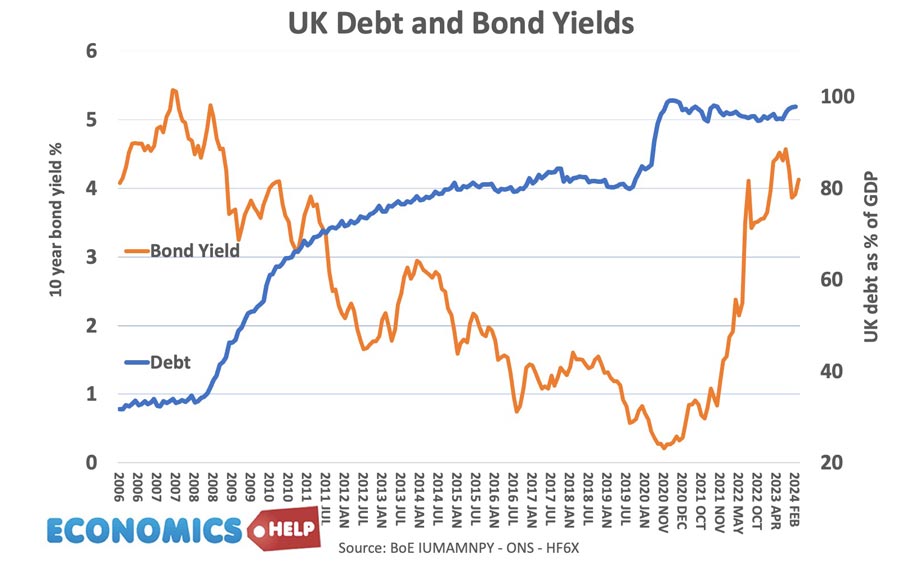
Between 2007 and 2020, UK bond yields fell. Countries in the Eurozone with similar debt levels saw a sharp rise in bond yields putting greater pressure on their government to cut spending quickly. However, being outside the Euro with an independent Central Bank (willing to act as lender of last resort to the government) means markets don’t fear a liquidity crisis in the UK; Euro members who don’t have a Central Bank willing to buy bonds during a liquidity crisis have been more at risk to rising bond yields and fears over government debt.
See also: Bond yields on European debt | (reasons for falling UK bond yields)
Since 2021, bond yields have risen due to pick up in inflation
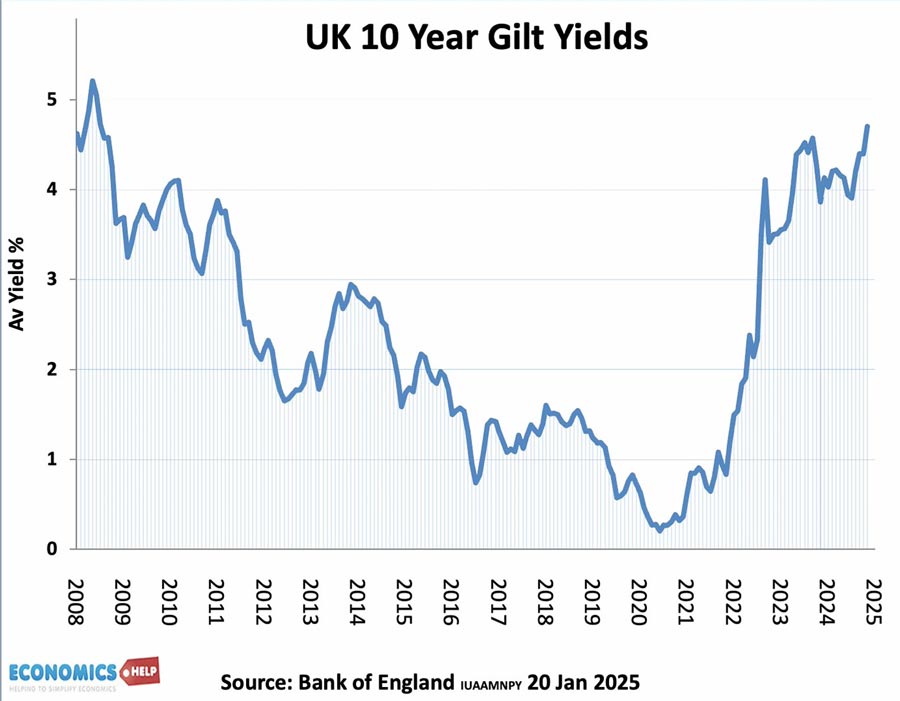
Cost of Interest Payments on National Debt
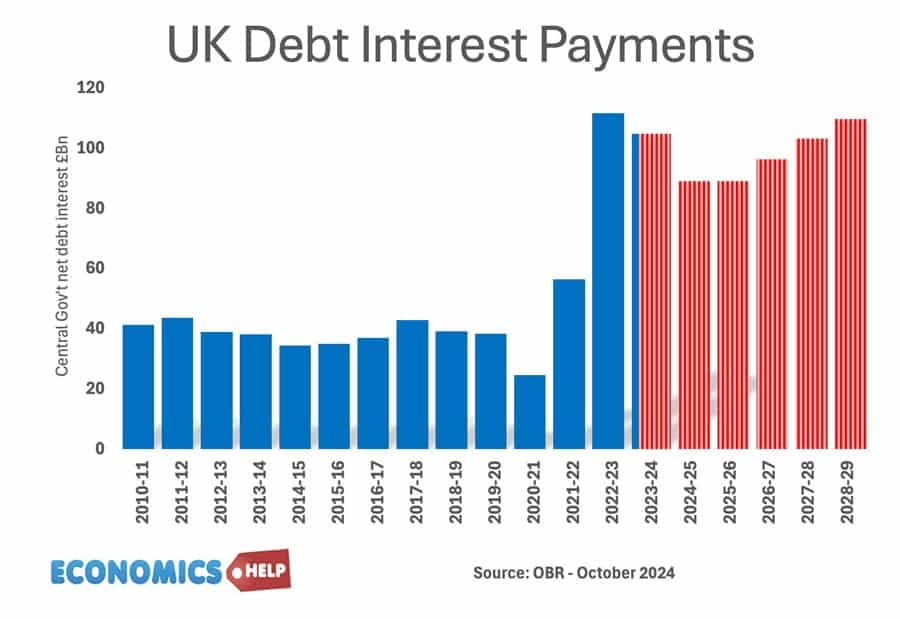
The cost of National debt is the interest the government has to pay on the bonds and gilts it sells. According to the OBR in 2023-24, debt interest payments will be £108 billion. (3.2% of GDP) or 5.2% of total spending. It is lower than in previous decades because of lower bond yields.
See also: UK Debt interest payments
The era of low interest rates post 1992 helped to reduce UK debt interest payments as a ratio of government revenue. However, with interest rates and borrowing increasing – debt interest cost have increased significantly.
Potential problems of National Debt
- Interest payments. The cost of paying interest on the government’s debt is very high. In 2011 debt interest payments will be £48 billion a year (est 3% of GDP). Public sector debt interest payments will be the 4th highest department after social security, health and education. Debt interest payments could rise close to £70bn given the forecast rise in national debt.
- Higher taxes / lower spending in the future.
- Crowding out of private sector investment/spending.
- The structural deficit will only get worse as an ageing population places greater strain on the UK’s pension liabilities. (demographic time bomb)
- Potential negative impact on the exchange rate (link)
- Potential of rising interest rates as markets become more reluctant to lend to the UK government.
However, government borrowing is not always as bad as people fear.
- Borrowing in a recession helps to offset a rise in private sector saving. Government borrowing helps maintain aggregate demand and prevents a fall in spending.
- In a liquidity trap and zero interest rates, governments can often borrow at very low rates for a long time (e.g. Japan and the UK) This is because people want to save and buy government bonds.
- Austerity measures (e.g. cutting spending and raising taxes) can lead to a decrease in economic growth and cause the deficit to remain the same % of GDP. Austerity measures and the economy | Timing of austerity
Who owns UK Debt?
The majority of UK debt used to be held by the UK private sector, in particular, UK insurance and pension funds. In recent years, the Bank of England has bought gilts taking its holding to 25% of UK public sector debt.

Source: DMO Debt Management Report 2022/23
- Overseas investors own about 28% of UK gilts (2022).
- The Asset Purchase Facility is purchases by the Bank of England as part of quantitive easing. This accounts for 26% of gilt holdings.
Total UK Debt – government + private
- Another way to examine UK debt is to look at both government debt and private debt combined.
- Total UK debt includes household sector debt, business sector debt, financial sector debt and government debt. This is over 500% of GDP. Total UK Debt
Private sector savings
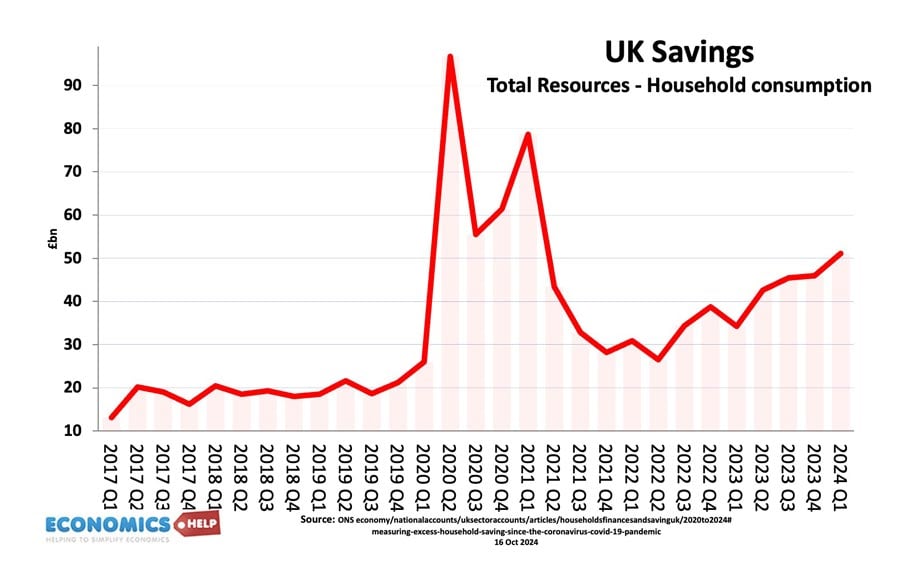
When considering government borrowing, it is important to place it in context. From 2007 to 2012, we have seen a sharp rise in private sector saving (UK savings ratio). The private sector has been seeking to reduce their debt levels and increase savings (e.g. buying government bonds). This increase in savings led to a sharp fall in private sector spending and investment. The increase in government borrowing is making use of this steep increase in private sector savings and helping to offset the fall in AD. see: Private and public sector borrowing
Comparison with other countries
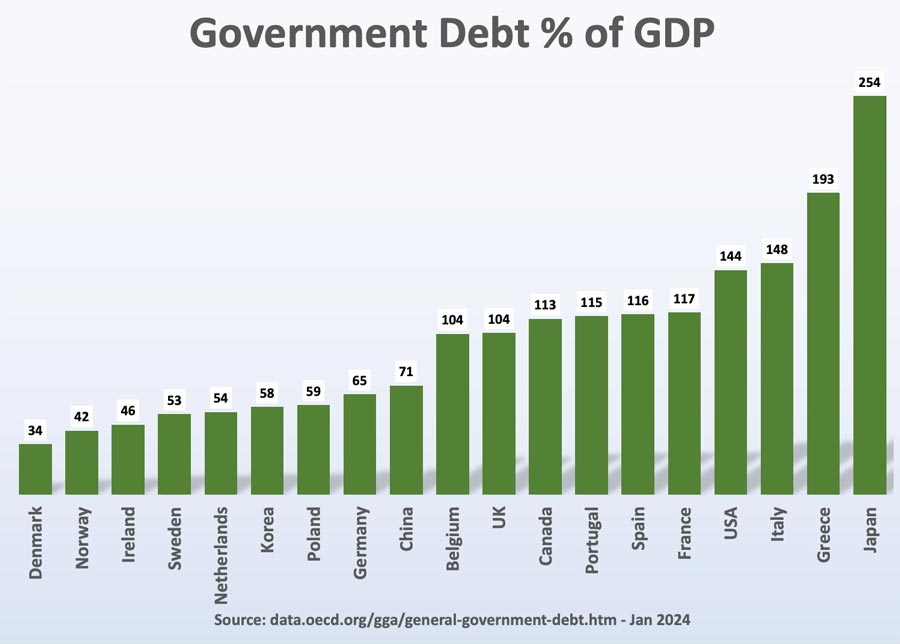
Although 107% of GDP is high by recent UK standards, it is worth bearing in mind that other countries have a much bigger problem. Japan, for example, has a National debt of 256%, Italy is over 157%. The US national debt is over 132% of GDP. [See other countries debt].
How to reduce the debt to GDP ratio?
- Economic expansion which improves tax revenues and reduces spending on benefits like Job Seekers Allowance. The economic slowdown which has occurred since 2010 has pushed the UK into a period of slow economic growth – especially if we consider GDP per capita growth. Therefore the further squeeze on tax revenues has led to deficit-reduction targets being missed.
- Government spending cuts and tax increases (e.g. VAT) which improve public finances and deal with the structural deficit. The difficulty is the extent to which these spending cuts could reduce economic growth and hamper attempts to improve tax revenues. Some economists feel the timing of deficit consolidation is very important, and growth should come before fiscal consolidation.
- See: practical solutions to reducing debt without harming growth
Other countries debt
See also:

Hi
I am looking for historical gdp data from ireland.
Any idea where can I find it?
Thnaks
Great blog here. Will be back again
i think the govermentshould not take any monye off of any 1 and get a real job them selves ant then they give us there money… see how they like it! im only 16 and this would is mest up befor imeaven in it
First saw this article, so, there are a lot of you don’t understand something. learned
good
Thanks a lot for this post, it was very useful.
I was wondering if you had anything to say about Johann Hari’s recent comments on national debt, explained here
http://johannhari.com/2011/03/29/the-biggest-lie-in-british-politics
Hi, You know what. I feel sorry for the government. Years and years of carelessness spending by other parties to boost aggregate demand and economic growth has now met its disastrous fate, and the coalition has to ‘somehow’ solve all of this. I’m sorry I can see many people complaining on this blog about the spending cuts etc etc, but to be honest they were a long time coming.
I can see many people complaining on this blog about the spending cuts etc etc, but to be honest they were a long time coming.
The problem of reducing our national debt is totally handicapped by the mentality of economic and political thinking that ignores where the seeds of economic dynamism resides.
In a mere twenty-year’s time to 2031, the UK and the EU will be reaching the limits of despair when trying to capture any major future foothold in the global economic stakes. This will not be due to its people, but their governments with regard to current and medium-term policies. These policies are inherently based in the old thinking that by joining universities and business together we can achieve economic dynamism in the future. It forgets that there are three crucial elements to achieve this – the ‘Ideas’ phase, the R&D phase and the corporate commercialization phase. I say forget, as the primer of this most important energiser for economic wealth creation, the ideas phase, is not taken serious and where it is the most important and fundamental missing factor. For without world changing ideas first the process cannot even begin. The British and EU system does not comprehend what the history of S&T tells us where up to 75% of all the inventions that have made the modern world what it is today, did not emanated within the confines of our universities or advanced corporate research centres of excellence, but in the minds of ‘independent’ innovators, far remote from the final two innovation elements that constitute the ‘innovation chain’. Indeed, the ‘independent’ ideas element is more-or-less nonexistent in UK and EU economic policy. This is unlike what is emerging in the East and where they are now starting to see that the ideas people are the most important commodity that a nation has. In twenty years time therefore with this lack of foresight and new thinking in Britain and the EU, we shall in reality just be hangers-on in the global economic stakes. Therefore for its own good, the United Kingdom and the EU have to start thinking ‘out of the box’ and give total prominence and resources to the initial ideas people. For if they do not we shall see in our own lifetime the inevitable collapse of living standards, the like of which we have shall never have seen before and where our offspring will live to be totally subservient to the economic might and power of the East. That is why it is so vitally important that we create now the innovative infrastructure throughout Europe for our ideas people to flourish and thereby equip our nations with the dynamic products and services that we shall dearly need. When will the UK and the EU realise this is the big question, for it has the most overriding repercussions and consequential economic effects that have never been seen before for the 500 million+ people of the European Union? We really have to start thinking ‘out-of-the-box’ like our Eastern counterparts before it is far too late to stem the economic decline that is now upon us all.
Dr David Hill
Executive Director
World Innovation Foundation
Given that we have bailed out some of our major banks. Why can we not sell off these assets to considerably ,or perhaps clear most of our debt?
no solutions here, Uk in debt they deserve it, they are a bunch of crooks! they wouldn’t run a surplus if your kids lives depended on it, would they.
with the recession of our finanical sector has been underminded in terms of america’s economic status. how do you mange to counter this counterevolutionary ideologies and sustain the climate of our society for our hedonistic society?